NCERT Class 7 Maths Ganita Prakash Chapter 2 Arithmetic Expressions Solutions
2.1 Simple Expressions
NCERT In-Text Question Page 24
Question: Choose your favourite number and write as many expressions as you
can having that value.
Solution:-
Figure it out (Page 25)
Question 1: Fill in the blanks to make the expressions equal on both sides of the = sign:
(a) 13 + 4 = __ + 6
(b) 22 + __ = 6 × 5
(c) 8 × __ = 64 ÷ 2
(d) 34 – __ = 25
Solution:
Question 2: Arrange the following expressions in ascending (increasing) order of their values.
(a) 67 – 19
(b) 67 – 20
(c) 35 + 25
(d) 5 × 11
(e) 120 ÷ 3
Solution:
NCERT In-Text Questions (Page 26)
Comparing Expressions
Question: Use ‘>’ or ‘<’ or ‘=’ in each of the following expressions to compare them. Can you do it without complicated calculations? Explain your thinking in each case.
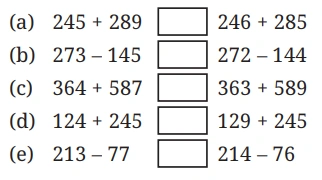
Solution:
NCERT In-Text Questions (Pages 28-29)
Terms in Expressions
Question: Check if replacing subtraction by addition in this way does not change the value of the expression, by taking different examples.
Solution:
Question: Can you explain why subtracting a number is the same as adding its inverse, using the Token Model of integers that we saw in the Class 6 textbook of mathematics?
Solution:
NCERT In-Text Question (Page 29)
Question: Complete the Table
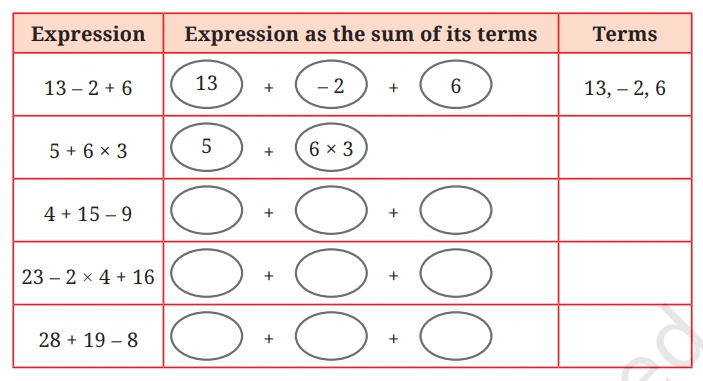
Question: Does changing the order in which the terms are added give different values?
Solution:
Question: Will this also hold when there are terms having negative numbers as well? Take some more expressions and check.
Solution:
NCERT In-Text Question Page 30
Question: Can you explain why this is happening using the Token Model of integers that we saw in the Class 6 textbook of mathematics?
Solution:
Question: Will this also hold when there are terms having negative numbers as well? Take some more expressions and check.
Solution:
Question: Can you explain why this is happening using the Token Model of integers that we saw in the Class 6 textbook of mathematics?
Solution:
NCERT In-Text Question Page 31
Question: Does adding the terms of an expression in any order give the same value? Take some more expressions and check. Consider expressions with more than 3 terms also.
Solution:
Question: Can you explain why this is happening using the Token Model of integers that we saw in the Class 6 textbook of mathematics?
Solution:
Question: Manasa is adding a long list of numbers. It took her five minutes to add them all and she got the answer 11749. Then she realised that she had forgotten to include the fourth number 9055. Does she have to start all over again? (Numbers list: 1342, 774, 8611, 9055, 1022)
Solution:
Question: Manasa is going outside to play. Her mother says, “Wear your hat and shoes!” Which one should she wear first?
Solution:
NCERT In-Text Question Page 32
Question: If the total number of friends goes up to 7 and the tip remains the same, how much will they have to pay? Write an expression for this situation and identify its terms.
Solution:
Question: Think and discuss why she wrote this. The expression written as a sum of terms is—

Solution:
NCERT In-Text Question Page 33
Question: For each of the cases below, write the expression and identify its terms:
If the teacher had called out ‘4’, Ruby would write __
If the teacher had called out ‘7’, Ruby would write __
Write expressions like the above for your class size.
Solution:
Question: Identify the terms in the two expressions above.
Solution:
Question: Can you think of some more ways of giving ₹432 to someone?
Solution:
NCERT In-Text Question Page 34
Figure it Out
Question 1: Find the values of the following expressions by writing the terms in each case.
(a) 28 – 7 + 8
(b) 39 – 2 × 6 + 11
(c) 40 – 10 + 10 + 10
(d) 48 – 10 × 2 + 16 ÷ 2
(e) 6 × 3 – 4 × 8 × 5
Solution:
Question 2: Write a story/situation for each of the following expressions and find their values.
(a) 89 + 21 – 10
(b) 5 × 12 – 6
(c) 4 × 9 + 2 × 6
Solution:
Question 3: For each of the following situations, write the expression describing the situation, identify its terms and find the value of the expression.
(a) Queen Alia gave 100 gold coins to Princess Elsa and 100 gold coins to Princess Anna last year. Princess Elsa used the coins to start a business and doubled her coins. Princess Anna bought jewellery and has only half of the coins left. Write an expression describing how many gold coins Princess Elsa and Princess Anna together have.
(b) A metro train ticket between two stations is ₹40 for an adult and ₹20 for a child. What is the total cost of tickets:
(i) for four adults and three children?
(ii) for two groups having three adults each?
(c) Find the total height of the window by writing an expression describing the relationship among the measurements shown in the picture.
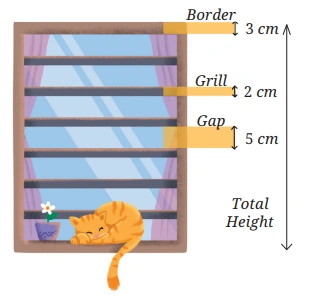
Solution:
NCERT In-Text Question Page 34
Question:
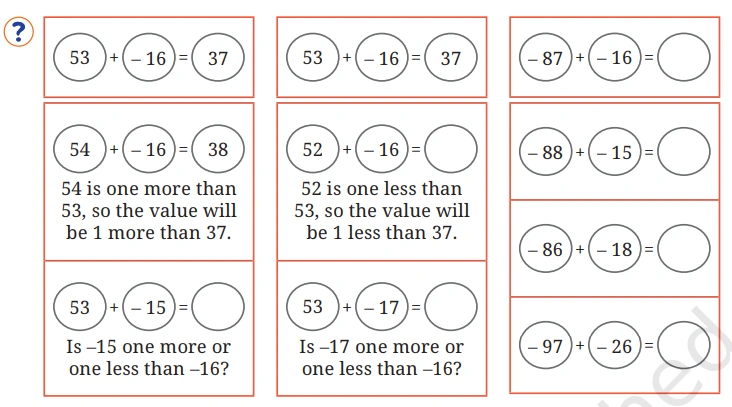
Figure it Out
Question 1: Fill in the blanks with numbers, and boxes with operation signs such that the expressions on both sides are equal.
(a) 24 + (6 – 4) = 24 + 6 _
(b) 38 + (_ _) = 38 + 9 – 4
(c) 24 – (6 +4) = 24 6 – 4
(d) 24 – 6 – 4 = 24 – 6 _
(e) 27 – (8 + 3) = 27 8 3
(f) 27– (_ _) = 27 – 8 + 3
Solution:
Question 2: Remove the brackets and write the expression having the same value.
(a) 14 + (12 + 10) (b) 14 – (12 + 10)
(c) 14 + (12 – 10) (d) 14 – (12 – 10)
(e) –14 + 12 – 10 (f) 14 – (–12 – 10)
Solution:
Question 3: Find the values of the following expressions. For each pair, first try to guess whether they have the same value. When are the two expressions equal?
(a) (6 + 10) – 2 and 6 + (10 – 2)
(b) 16 – (8 – 3) and (16 – 8) – 3
(c) 27 – (18 + 4) and 27 + (–18 – 4)
Solution:
NCERT In-Text Page 38
Question 4: In each of the sets of expressions below, identify those that have the same value. Do not evaluate them, but rather use your understanding of terms.
(a) 319 + 537, 319 – 537, – 537 + 319, 537 – 319
(b) 87 + 46 – 109, 87 + 46 – 109, 87 + 46 – 109, 87 – 46 + 109, 87 – (46 + 109), (87 – 46) + 109
Solution:
Question 5: Add brackets at appropriate places in the expressions such that they lead to the values indicated.
(a) 34 – 9 + 12 = 13
(b) 56 – 14 – 8 = 34
(c) –22 – 12 + 10 + 22 = – 22
Solution:
Question 6: Using only reasoning of how terms change their values, fill the blanks to make the expressions on either side of the equality (=) equal.
(a) 423 + = 419 +
(b) 207 – 68 = 210 – __
Solution:
Question 7: Using the numbers 2, 3 and 5, and the operators ‘+’ and ‘–’, and brackets, as necessary, generate expressions to give as many different values as possible. For example, 2 – 3 + 5 = 4 and 3 – (5 – 2) = 0.
Solution:
Question 8: Whenever Jasoda has to subtract 9 from a number, she subtracts 10 and adds 1 to it. For example, 36 – 9 = 26 + 1.
(a) Do you think she always gets the correct answer? Why?
(b) Can you think of other similar strategies? Give some examples.
Solution:
Question 9: Consider the two expressions: a) 73 – 14 + 1, b) 73 – 14 – 1. For each of these expressions, identify the expressions from the following collection that are equal to it.
(a) 73 – (14 + 1)
b) 73 – (14 – 1)
(c) 73 + (– 14 + 1)
d) 73 + (– 14 – 1)
Solution:
Page 39
Question: If another friend, Sangmu, joins them and orders the same items, what will be the expression for the total amount to be paid?
Solution:
Page 40
Question:
5 × 4 + 3 ≠ 5 × (4 + 3). Can you explain why?
Solution:
Question:
Is 5 × (4 + 3) = 5 × (3 + 4) = (3 + 4) × 5?
Solution:
Page 41
Question:
97 × 25 = 100 × 25 – 3 × 25 Find this value.
Solution:
Question: Use this method to find the following products:
(a) 95 × 8
(b) 104 × 15
(c) 49 × 50
Is this quicker than the multiplication procedure you use generally?
Solution:
Question: Which other products might be quicker to find like the ones above?
Solution:
Figure it Out
Question 1. Fill in the blanks with numbers, and boxes by signs, so that the expressions on both sides are equal.
(a) 3 × (6 + 7) = 3 × 6 + 3 × 7
(b) (8 + 3) × 4 = 8 × 4 + 3 × 4
(c) 3 × (5 + 8) = 3 × 5 ☐ 3 × _____
(d) (9 + 2) × 4 = 9 × 4 ☐ 2 ×__
(e) 3 × (_ + 4) = 3 +___
(f) (+ 6) × 4 = 13 × 4 +
(g) 3 × (+) = 3 × 5 + 3 × 2
(h) (+)×__= 2 × 4 + 3 × 4
(i) 5 × (9 – 2) = 5 × 9 – 5 × __
(j) (5 – 2) × 7 = 5 × 7 – 2 × __
(k) 5 × (8 – 3) = 5 × 8 ☐ 5 × __
(l) (8 – 3) × 7 = 8 × 7 ☐ 3 × 7
(m) 5 × (12 –) = ☐ 5 ×__
(n) (15 –) × 7 = ☐ 6 × 7
(o) 5 × (–) = 5 × 9 – 5 × 4
(p) (–) × __= 17 × 7 – 9 × 7
Solution:
Page 42
Question 2: In the boxes below, fill ‘<’, ‘>’ or ‘=’ after analysing the expressions on the LHS and RHS. Use reasoning and understanding of terms and brackets to figure this out and not by evaluating the expressions.
(a) (8 – 3) × 29 ▭ (3 – 8) × 29
(b) 15 + 9 × 18 ▭ (15 + 9) × 18
(c) 23 × (17 – 9) ▭ 23 × 17 + 23 × 9
(d) (34 – 28) × 42 ▭ 34 × 42 – 28 × 42
Solution:
Question 3: Here is one way to make 14: 2 × ( 1 + 6 ) = 14. Are there other ways of getting 14? Fill them out below:
(a) _______ × ( ___+____) = 14
(b) _______ × ( ___+____) = 14
(c) _______ × ( ___+____) = 14
(d) _______ × ( ___+____) = 14
Solution:
Question 4: Find out the sum of the numbers given in each picture below in at least two different ways. Describe how you solved it through expressions.
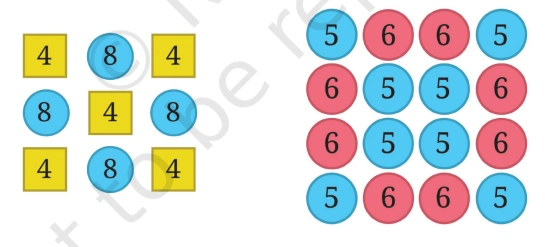
Solution:
Page 42-43
Figure it Out
Question1: Read the situations given below. Write appropriate expressions for each of them and find their values.
(a) The district market in Begur operates on all seven days of a week. Rahim supplies 9 kg of mangoes each day from his orchard and Shyam supplies 11 kg of mangoes each day from
his orchard to this market. Find the amount of mangoes supplied by them in a week to the local district market.
(b) Binu earns ₹20,000 per month. She spends ₹5,000 on rent, ₹5,000 on food, and ₹2,000 on other expenses every month. What is the amount Binu will save by the end of a year?
(c) During the daytime a snail climbs 3 cm up a post, and during the night while asleep, accidentally slips down by 2 cm. The post is 10 cm high, and a delicious treat is on its top. In how many days will the snail get the treat?
Solution:
Question 2: Melvin reads a two-page story every day except on Tuesdays and Saturdays. How many stories would he complete reading in 8 weeks? Which of the expressions below describes this scenario?
(a) 5 × 2 × 8
(b) (7 – 2) × 8
(c) 8 × 7
(d) 7 × 2 × 8
(e) 7 × 5 – 2
(f) (7 + 2) × 8
(g) 7 × 8 – 2 × 8
(h) (7 – 5) × 8
Solution:
Question 3: Find different ways of evaluating the following expressions:
(a) 1 – 2 + 3 – 4 + 5 – 6 + 7 – 8 + 9 – 10
(b) 1 – 1 + 1 – 1 + 1 – 1 + 1 – 1 + 1 – 1
Solution:
Question 4: Compare the following pairs of expressions using ‘<’, ‘>’ or ‘=’ or by reasoning.
(a) 49 – 7 + 8 49 – 7 + 8
(b) 83 × 42 – 18 83 × 40 – 18
(c) 145 – 17 × 8 145 – 17 × 6
(d) 23 × 48 – 35 23 × (48 – 35)
(e) (16 – 11) × 12 –11 × 12 + 16 × 12
(f) (76 – 53) × 88 88 × (53 – 76)
(g) 25 × (42 + 16) 25 × (43 + 15)
(h) 36 × (28 – 16) 35 × (27 – 15)
Solution:
Question 5: Identify which of the following expressions are equal to the given expression without computation. You may rewrite the expressions using terms or removing brackets. There can be more than one expression which is equal to the given expression.
(a) 83 – 37 – 12
(i) 84 – 38 – 12
(ii) 84 – (37 + 12)
(iii) 83 – 38 – 13
(iv) – 37 + 83 –12
(b) 93 + 37 × 44 + 76
(i) 37 + 93 × 44 + 76
(ii) 93 + 37 × 76 + 44
(iii) (93 + 37) × (44 + 76)
(iv) 37 × 44 + 93 + 76
Solution:
Question 6: Choose a number and create ten different expressions having that value.
Solution: